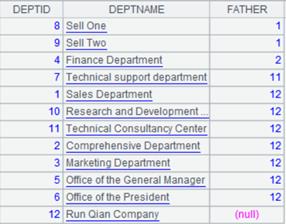cs.sortx()
Description:
Sort data of a cursor.
Syntax:
cs.sortx(x,…;n)
Note:
The function sorts cursor cs by expression x, and returns result as a cursor. The cursor the function returns is irreversible.
Parameter:
|
cs |
A cursor |
|
x |
An expression to sort members of cursor cs in ascending order |
|
n |
Number of buffer rows; if the number of groups reaches n, write the grouping result to a temporary file; its value will be n times of the default if it is less than 1; by default, esProc will auto-compute the value |
Option:
|
@0 |
Put records with null values at the end; @0 and @n can’t work together |
|
@n |
It can only be used to make the calculation faster when the value of expression x is a positive integer over which group of records can be directly numbered. @0 and @n can’t work together |
|
@g |
Treat parameter n as the segmentation expression by which records are first segmented and then grouped and sorted |
Return value:
Cursor
Example:
|
|
A |
|
|
1 |
=demo.cursor("select NAME,BIRTHDAY,HIREDATE from Employee") |
Return retrieved data as a cursor. |
|
2 |
=A1.sortx(BIRTHDAY) |
Sort the cursor’s BIRTHDAY field. |
|
3 |
=A2.fetch() |
Retrieve data from cursor A2. |
|
4 |
=demo.cursor("select * from DEPT") |
Return retrieved data as a cursor. |
|
5 |
=A4.sortx@0(FATHER).fetch() |
Sort records in the cursor by FATHER field and put the one with null value at the end. |
|
6 |
=A4.sortx@g(DEPTID;FATHER==12).fetch() |
Group records according to whether FATHER value is 12 and then sort each group by DEPTID. |
|
7 |
=A1.sortx(BIRTHDAY;2) |
Sort BIRTHDAY field in the cursor; since data is divided into two groups to be processed, write the grouping result to a temporary file. |
|
8 |
=demo.cursor("select * from SCORES") |
|
|
9 |
=A8.sortx@n(SCORE).fetch() |
The result of fetching SCORE values are integers; here @n option is used to speed up the sorting. |
Related function:

